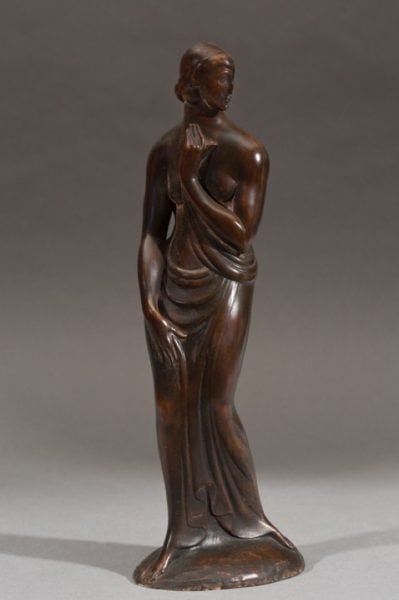Pudeur (Draped Figure; Standing Woman), Circa 1915–17, cast before 1930
Gaston LachaiseBronze
13 3⁄4 inches high
Inscribed: G. LACHAISE/ 1917
Inscribed: ROMAN BRONZE WORKS N–Y–
Provenance
Private Collection, Yorktown Heights, New York.
Gerald Peters Gallery, New York.
Private Collection, New York, from the above.
Pudeur (Draped Figure; Standing Woman) [LF 18]
Five other lifetime casts are presently located.
The present model is reported by Lachaise’s sister Allys to have been inspired by her own momentary pose. A bronze cast was included in Lachaise’s first solo show at the Bourgeois Galleries in 1918 and copyrighted in that same year. An illustration of that cast accompanies a review of the show by Caroline Caffin, “New, Important Things in Art: A Sculptor of Elemental Rhythms,” New York American, February 25, 1918, p. 6. Virginia Budny notes: “a very clear design controls the composition, a design … combined with a synthetic treatment of the figure itself… both monolithic and easy to grasp and hold in the hand. [The] rhythms are designed to lead the eye around and over the figure so as to accentuate the full volumes and stress their beauty.” (Virginia Budny, “Gaston Lachaise’s American Venus: The Genesis and Evolution of Elevation,” The American Art Journal, Vols. 34–35 [2003–04].
Pudeur was well received by both critics and the public. According to a letter by the poet E. E. Cummings to his mother dated July 4, 1918 (Letters of E.E. Cummings, p. 48, no. 35), one or more casts of Pudeur were sold at the time of Lachaise’s first solo show. Other casts are in the collections of The Metropolitan Museum of Art; the Memorial Art Gallery, University of Rochester; as well as the Hirshhorn Museum; the Lachaise Foundation, as well as in a Private collection. The artist’s plaster model is lost.
Exhibited
- New York, New York, Gerald Peters Gallery, Works by Gaston Lachaise: A Modern Epic Vision, November 15–December 21, 2012.


